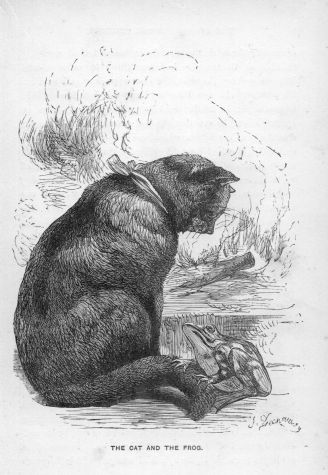| |
|
- Work with the owner to reduce their stress level about having to medicate their cat - owner
stress predictably increasing patient stress related to the medication
admin issue
- Feloway® or DAP® diffusers in the home may
help reduce patient stress
- WHERE people do meds is very
important to avoid having the "cat run when he sees me
coming" scenario. Always have ONE place to do treatments (even if
cat likes the meds in a treat/etc.). Consider
a closed small room with good light, and some place to have the
patient where the owner can easily access the cat.
- Always have cat on a non-skid surface: bath mat, rug with
non-skid base. Since many of these patients are geriatric,
arthritic, and in pain, you should place a soft towel, fleece throw,
cat bed, or a pillow on top of the non-skid surface to make it soft,
warm, and cushy. The bedding can be warmed up in a dryer prior to
its use.
- Bathroom,
top of clothes washer/dryer. Then person can get a good view of
mouth, holding head etc to optimize success.
- In a
bathroom it can be helpful to use the sink as a "nest"
making it harder for the cat to back away from you - put something
soft, warm, and cushy in the sink.
- Big chair
with cat in a corner
- If easier
for owner to sit on floor with cat in/on lap - use a specific room,
with door - where ONLY that happens.
- Use a
“cat sack” (where head sticks out with zippers to access legs,
etc). For home treatments, the cat bag is not only the signal that
it's "vetlike" time, but keeps cat from backing up.
See: www.fourflags.com.
- Find a phrase you say when
it's med time (or fluids time, or any "vet-like" time). This
clues cat, and sets your own body language/communication.
- Direct pilling considerations:
- Make sure
owners know that there are pill crushers/splitters (vet supply or
human pharmacy)
- Crush tab and place in gel cap
(available in flavored varieties ) if owner can manage direct
capsule administration (eliminates the "taste" of the
meds)
- Coat the tab lightly with butter, margarine, or vegetable oil to reduce the taste of the medication and facilitate its
passage
- Coat tablets in a single layer of
Kleenex - hides the taste similarly to a gel cap and more easily
available. The Kleenex is easily digested.
- Pilling gun – place meds in pilling
gun, then dipped in food before delivery
- Consider stroking the throat and
giving either a small wet food meal or a water chaser after direct pilling
to prevent having the medication hang up in the esophagus
- Crush tab or open capsule and mix with favorite cat
food
- Caution!! Cats may develop a food aversion towards their support diets when
owners mix in drugs. It may be wise to test drugs with some other
diet first prior to mixing them in to medical diets.
- Crush tab or open capsule and mix
with tuna fish or other favored NON-cat food including meat flavored
baby food
- Crush pill, mix with butter, honey, or laxatone and
rub on paws so cat licks if off.
- Take a three ml syringe without the needle. Cut off the
tip (do NOT use your expensive surgical scissors. The pill or halves
or quarters thereof can be placed into the syringe with the plunger
pulled back. Stuff wet cat food into barrel to hold pill in place.
Place to back of cat's mouth and "pop". Cost approximately
25 cents (more if you continually use you surgical scissors for
preparation).
- Mix crushed meds with cat
food can gravy; give through 3cc oral syringe. This often works great
since cats commonly prefer the gravy. Take the gravy from canned cat
food (either the cat's favorite one, or a brand with lots of gravy -
Friskies Buffet Poultry, some of the fish flavors, and Whiskas
Mealtime Kitty Stew) - mix crushed meds in - give with 3cc oral
syringe (that way if there are small pieces of food they won't get
stuck)
- Additional “treats” to
hide pills in. This could be any treat that your cat likes/might like
that you can hide the medication in. Even cats that dislike canned cat
food may take their medications in a “treat”.
- Hide tab or cap in Pill Pocket: http://www.pillpockets.com/main.htm
- Hide tab or cap in Flavor-doh: http://www.flavordoh.com
- Have medication compounded in a cat
friendly flavored liquid
- Have medication compounded in a cat
friendly flavored chewy treat
- http://www.bcpvetpharm.com/products_vetchews.htm
- Friskies
TENDER (not the crunchy) treats in the foil pouch. There are several
different flavors, and they are slightly different shapes. The ones
that work best for pills are the Poultry and the Salmon ones. Others
are too flat to hold a pill/piece of pill. Only downside is they dry
out and crumble if not kept airtight - so reseal the resealable bag,
or transfer to something like a Tupperware airtight snack container.
- Use treat with crunchy outside and soft inside
like Whiskas snacks and Pounce Hairball Treats. The pill/piece must be small enough to fit
inside the treat. Carefully split in half with a sharp knife and
place meds inside, then press closed. The crunchy outside helps
disguise the medicine inside.
- Cheese Whiz
processed cheese spread
- Use transmucosally absorbed drugs
- Obtain injectable version and have owner administer SQ
using U-100 lo-dose insulin syringe (if medication is effective when
delivered SQ)
- When ALL else fails, consider compounding in a PLO gel
and attempt transdermal delivery (although the effectiveness of this
method is questionable)
|

